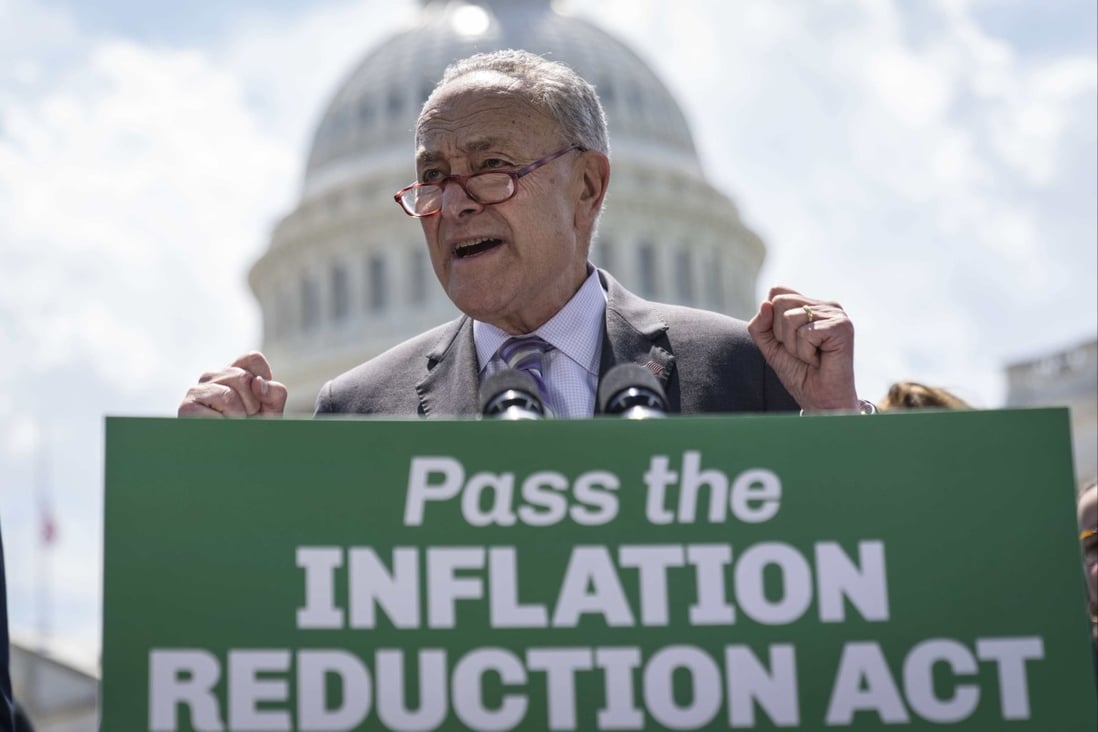Set against the estimated multi-trillion-dollar cost of dealing with global warming, Washington’s US$430 billion in a recently passed bill is hardly overwhelming
Furthermore, the prospects for global climate action do not look bright when the world’s top two carbon emitters, the US and China, can’t cooperate
Anthony Rowley
Published: 14 Aug, 2022

US Senate majority leader Chuck Schumer speaks during a news conference about the Inflation Reduction Act outside the US Capitol in Washington on August 4. Photo: AFP
The much-feted Inflation Reduction Act passed by the US Senate last week is more about the United States playing catch-up on climate change than it is about inflation. It is welcome on the grounds that every little bit counts, yet the US is still being outspent by China on climate remediation.
The US$430 billion price tag on the legislation – of which US$370 billion is for fiscal outlays on climate change over the next 10 years – is hardly inconsequential. But set against the estimated multi-trillion-dollar cost of dealing with global warming, neither is it overwhelming.
It is hoped, by experts such as Dan Lashof, US director of the World Resources Institute, that the American initiative will induce China, currently the biggest global emitter of greenhouse gases, and others to increase their targeted spending on climate change.
Some of these other nations, not least India, do need to do more in this regard because, as Bruno Carraso, director general for sustainable development and climate change at the Asian Development Bank, noted during a panel discussion I moderated at the Foreign Correspondents’ Club of Japan in Tokyo recently, the Asia-Pacific region produces more than half of global carbon dioxide emissions.
As Carrasco put it, the battle against climate change “will be won or lost” in the Asia-Pacific region.
But before anyone can be sure how much more Asia – or indeed the US, the European Union and other regions – needs to contribute, we need to get a better handle on what the global cost of climate change mitigation and adaptation will really be. At present, this is almost anyone’s guess.
Estimates range from hundreds of billions a year to US$100 trillion over 30 years, depending on whether they come from the United Nations, the World Bank, the Glasgow Financial Alliance for Net Zero (GFANZ), or other institutions. Morgan Stanley has said US$50 trillion of investment is needed over the next three decades in renewable energy, electric vehicles, carbon capture, hydrogen production and biofuels.
Confusion over costs also arises from the fact that no one is clearly in charge of organising who does what or who pays how much when it comes to dealing with the existential threat of climate change. That in turn is symptomatic of the sadly fractured state of international relations.
Ironically, at the same time that the US was basking in the triumphal glow of taking the lead on climate change, by virtue of the Biden administration’s spending package, China was publicly eschewing cooperation with the US on climate issues as a result of rising tensions over Taiwan.
Some have suggested that this development may actually benefit Planet Earth and save its inhabitants from extinction; certainly, if major powers seek to outdo one another on climate change mitigation, the result could be a lot more positive action.
This seems to imply that, on climate issues as in the diplomatic sphere, “America is back”, to quote US President Joe Biden. But the prospect of the world’s two largest economies and carbon dioxide emitters, the US and China, carving up the world between them on climate change is absurd.
What I termed in the title of a recent book I wrote as “the global battle for infrastructure” is highly applicable now to the climate fight. China went ahead and launched its Belt and Road Initiative, whereupon the US, along with European allies, launched a belated, competitive response.
The result? An uncoordinated series of plans – for everything from railway gauges to power grid design – that hardly serves the cause of efficient logistics designed with global welfare in mind. This process has been exacerbated by the advent of rival US and China supply chains.
At the UN climate change conference, COP27, to be held in Sharm el-Sheikh in Egypt in November, the US and China can be expected to confront each other, rather than cooperate on climate change, while other nations like India look on in dismay. Prospects for COP27 do not appear bright unless other powers such as Europe, whose record on climate change alleviation is good, or an alliance of Asian, Latin American and African nations, can mediate between the US and China and break their deadlock.
Even then, there are enemies within as well as from outside to be grappled with in the struggle to slow or halt climate change. The internal enemy could be reluctance on the part of the public to accept the necessary changes in lifestyle, as the ADB’s Carrasco observed.
“We need to be honest that there will be significant changes to our lifestyles” with a particular need for “intergenerational changes” in this regard, he said.
Alongside the passive reluctance to accept the implications of climate change for human behaviour, others are actively seeking to prevent climate action using sophisticated and cynical methods, according to Fletcher Harper, executive director of GreenFaith, a multi-faith climate movement.
Corporate lobbying against climate change action is carried out via low-profile influence peddling (or buying) campaigns that can thwart efforts to strengthen regulation of emissions, Dylan Tanner, executive director of Influence Map, a UK-based climate monitoring organisation, has suggested.
The battle is huge and it will need more than political initiatives from individual nations – be it the US or China – to marshal the global forces needed to win it. Rival armies will need to come together and fight shoulder to shoulder.

Anthony Rowley is a veteran journalist specialising in Asian economic and financial affairs. He was formerly Business Editor and International Finance Editor of the Hong Kong-based Far Eastern Economic Review and worked earlier on The Times newspaper in London
No comments:
Post a Comment